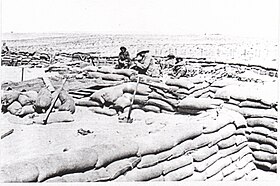Battle of Katia
| Battle of Katia | |||||||
|---|---|---|---|---|---|---|---|
| Part of the Middle Eastern theatre of World War I | |||||||
 1st Scottish Horse troopers in a redoubt at Duidar, Summer 1916 |
|||||||
|
|||||||
| Belligerents | |||||||
|
|
|
||||||
| Commanders and leaders | |||||||
|
|
|
||||||
| Units involved | |||||||
| 5th Mounted Brigade | 1st and 2nd Battalions 1 company of 32nd Regiment four companies of an irregular camel regiment and two independent companies |
||||||
| Strength | |||||||
| 1,500 | 3,650 | ||||||
| Casualties and losses | |||||||
| 500 | |||||||
The Battle of Katia, also known as the Affair of Qatia by the British, was an engagement fought east of the Suez Canal and north of El Ferdan Station, in the vicinity of Katia and Oghratina, on 23 April 1916 during the Defence of the Suez Canal Campaign of World War I. An Ottoman force led by the German General Friedrich Freiherr Kress von Kressenstein made a surprise attack on three and a half squadrons of the British 5th Mounted Brigade, which was widely scattered to the east of Romani. The mounted brigade had been ordered to the area to protect the new railway and water pipeline being built from Kantara on the Suez Canal, as this infrastructure extended out past the Canal's zone of defences into the Sinai Peninsula towards Romani. Kress Von Kressenstein's attack was completely successful, decimating the equivalent of little more than a regiment. On the same day, an associated Ottoman attack on Duidar, very close to the Suez Canal, failed when it met with strong British opposition.
Kress von Kressenstein's force had been active in the area since the First Suez Offensive of early 1915, when three columns attacked the Canal along the northern, central, and southern routes across the Sinai Peninsula. The growing Imperial strength made attacks on the Suez Canal difficult, and ended the dominance of the Ottoman force in the area. The Ottoman Empire's attacks on 23 April demonstrated their intention to continue opposing the British Empire in the region.
However, the Imperial reaction to these attacks was to double the strength of their forces. The 2nd Light Horse Brigade, and the New Zealand Mounted Rifles Brigade, were sent to Katia and Romani and established a strong Imperial presence over the contested ground. Soon after, the Australian 1st Light Horse Brigade was also sent forward, and the 52nd (Lowland) Division arrived at Romani not long after. At the beginning of August, the Battle of Romani was fought over much of the same ground as that at Katia.
...
Wikipedia
